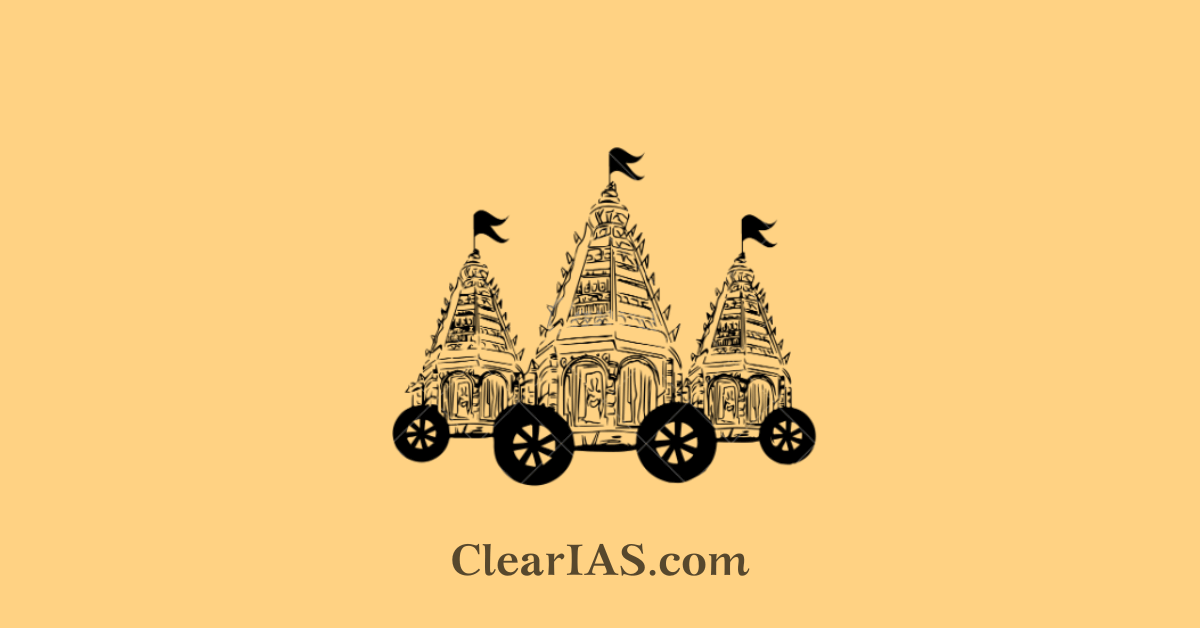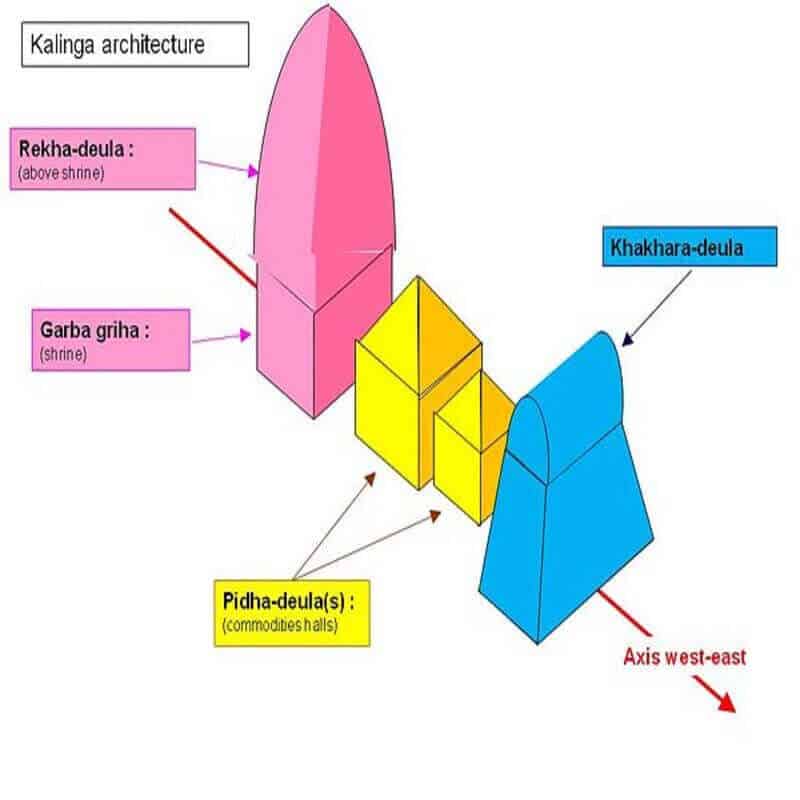
The Jagannath Temple is an important Hindu temple dedicated to Jagannath, or Lord Vishnu in Puri, Odisha. There has been a debate going around the entry of foreigners into the temple for decades which keeps surfacing in the news now and then. Read here to know more about the history of Puri Jagannath Temple.
The Puri Jagannath temple is one of the Char Dham pilgrimage sites in India. The other three Dham are Badrinath, Dwarka, and Rameswaram.
The annual Ratha Yatra, or chariot festival, at the Puri temple is well-known for featuring the three main deities being hauled by enormous, ornately decorated temple cars.
The icon of Jagannath is made of wood and ceremoniously replaced every twelve or nineteen years by a replica, in contrast to the stone and metal symbols found in the majority of Hindu temples. The Nabakalebara (re-embodiment) of the deities, replacing the old idols with new ones – is an elaborate process in which they relinquish their old bodies and assume a new ones.
The English word “juggernaut” originated from Jagannath, in the sense of a huge wagon due to the rath or chariot yathra at the temple.
The Jagannath Temple
Sri Shankaracharya visited Puri perhaps by 810 CE and founded the Govardhana Matha, since then Puri has gained special significance as one of the four Dham of India known as Char Dham.
The actual Char Dham in India refers to the bigger circuit of Char Dham which includes the four most holy pilgrimages of Hinduism in India, which are Badrinath, Dwarka, Rameswaram, and Puri.
- These holy places are located at the four corners of India Badrinath in the North, Dwarka in the West, Puri in the East, and Rameswaram in the South corner of the Indian landscape. Jagannath Temple is the eastern Dham.
The Temple of Puri Jagannath Odisha is one of the most significant temples in Puri, the capital of the state of Odisha.
The iconic Jagannatha temple in Puri is the city’s main draw. It has various names, including the Puri temple, the Srimandira, the Bada Deula, or just the Jagannatha temple.
- With a height of roughly 214 feet above ground level, the temple of Jagannatha is one of the highest buildings in the Indian subcontinent.
- It is perched atop a roughly ten-acre elevated stone platform.
- Two compound walls, the outer one known as Meghanada Pracira and the inner one known as Kurma Pracira, surround the temple.
- The temple building is a magnificent example of Kalinga-style architecture and is covered in gorgeous sculptures and excellent carvings.
- The Archaeological Survey of India presently looks after it.
Only traditional Hindus are permitted access to the Temple. Others are allowed to view some of the enclosure from the top of the Emar Matha building, which is close to the temple’s east-facing gate.
Jagannath, Balabhadra, and Subhadra are a trio of deities worshipped at the temple.
Also read: Temple Architecture and Sculpture – Hindu, Buddhist and Jain (Indian Culture Series – NCERT)
Rath Yatra
The Jagannath trinity is usually worshiped in the sanctum of the temple at Puri, but once during the month of Asadha (in June or July), they are brought out onto the main street of Puri and travel (3 km) to the Shri Gundicha Temple, in huge chariots (Ratha), allowing the public to have viewed.
History of Jagannath Temple
The temple was rebuilt by the Ganga dynasty king Anantavarman Chodaganga in the 12th century CE, as suggested by the Kendupatna copper-plate inscription of his descendant Narasimhadeva II.
The temple complex was further developed during the reigns of the subsequent kings, including those of the Ganga dynasty and the Gajapati dynasty.
The deities within the shrine are believed to be much older and are associated with the great mythical ruler of the Satya-yuga, King Indrayumna, nephew of Lord Ram.
In 1174 CE King Anang Bhim Deo ascended the throne of Orissa. Religious crisis struck the young king when he slew a Brahmin. Tradition relates that he invested greatly in construction projects for the public to expiate his sins.
- Among the temples that he built were the ancillary shrines and the walls of Jagannath temple which took fourteen years to achieve completion in 1198 CE.
- He organized the order of the temple servitors (Chattisanijoga) to manage the Temple built by his father.
- The murtis of Lord Jagannath and his siblings were revered and worshipped here without interruption until 1568.
The temple annals, the Madala Panji records that the Jagannath temple at Puri has been invaded and plundered eighteen times.
- In 1568, after defeating the Gajapati ruler Mukunda Deva, General Kalapahad led the victorious army of the Nawab of Bengal, Sultan Suleiman Karani into the Temple complex to loot it. The deities were destroyed.
In 1575, the deities were restored in Puri by Ramachandra Deva I of the Kingdom of Khurda.
- As an expression of their gratitude, the devotees bestowed Ramachandra Deva I with the name ‘Abhinav Indrayumna’ (Indrayumna incarnate).
- Within two decades, Ramachandra Deva I’s authority over Puri and the Temple was recognized even by the Mughal Empire.
- Raja Mansingh bestowed upon him the title of ‘Gajapati Ruler of Khurda and Superintendent of the Jagannath Temple’.
In 1692, Mughal Emperor Aurangzeb ordered to close off the temple until he wanted to reopen it. It was re-opened only after Aurangzeb died in 1707.
The Maratha and the British assumed control of the Temple complex in 1751 and 1803 respectively.
- Locally, however, the Rajas of Khurda would retain the trust of the devotees in managing the Temple and its rituals.
In 1809 the British East India Company officially returned the charge of the Temple to the Rajas who would retain control till British power itself was uprooted from the Indian subcontinent.
In 1975, the Archeological Survey of India undertook a project to remove the multiple layers of lime plaster to uncover the original designs beneath. The conservation project lasted for two decades.
The architecture of the temple

The Jagannatha temple is one the most refined piece of Kalingan Architecture.
The temple stands in the center of an inner courtyard on a high-raised platform. It has four components:
- Vimana or Deula (Garbagriha)
- Jagamohana
- Natamandapa
- Bhogamandapa
The architectural style of the Jagannath temple is a combination of two types-Rekha and Pidha.
- The vimana is built in the nagara style Rekha deula.
- The jagamohana is in the Pidha deula style.
The main temple, the sanctuary (Garbhagruha) is commonly known as Vimana or deula and is built in the framework of Nagara Sthaptya as a Rekha deula characterized by a curvilinear tower known as sikhar.
- The crowning at the top is the ‘Neelachakra’ (an eight-spoked wheel) of Lord Vishnu. It is made out of Ashtadhatu and is considered sacrosanct.
The viman or deula is built on the Pancha Ratha ground plan in such a manner that its vertical shape starting from the bottom up to the highest level of the curvilinear shikhara is divided into five projected column or pillar-like structure i.e rath in each of the four sides.
Here lies the unique architectural quality of the Pancha Ratha Rekha deula of Shree Jagannatha.
Both the Vimana (Sanctuary) and the porch (Jagamohana) are divided into five principal parts along the vertical plane through the foundation:
- pishta or pitha
- the bada (vertical or perpendicular wall)
- gandi (trunk of a body) i.e, the curvilinear tower in the case of a Rekha deula a
- pyramidal roof in the case of pidha deula
- mistake (head of the crowning elements)
The Natamandap (the audience hall) and the Bhoga Mandap (the hall for residuary offerings) are built in a row in an axial alignment in an east-west direction.
There are four gates to the temple- Eastern ‘Singhdwara’ which is the main gate with two crouching lions, Southern ‘Ashwadwara’, Western ‘Vyaghra Dwara, and Northern ‘Hastidwara’. There is a carving of each form at each gate.
In the news
2024: After years of legal battles, controversies and debates, the Ratna Bhandar, the sacred treasury of Shree Jagannath Temple, Puri was opened after 46 years on July 14.
- As per the inventory last made in 1978, the Ratna Bhandar comprising Bahar Bhandar (outer chamber) and Bhitar Bhandar (inner chamber) has a total of 454 gold articles having a net weight of 12,838 Bharis (128.38 kg) and 293 silver articles weighing 22,153 Bharis (221.53 kg).
- The Ratna Bhandar, situated at a height of 11.78 metres and measuring 8.79 m by 6.74 m, is located on the northern side of the Jagamohana (assembly hall of the temple). These chambers contain the jewels of the three sibling deities — Lord Balabhadra, Lord Jagannath, and Devi Subhadra.
-Article written by Swathi Satish






Very Help ful Article! Thank you so much for